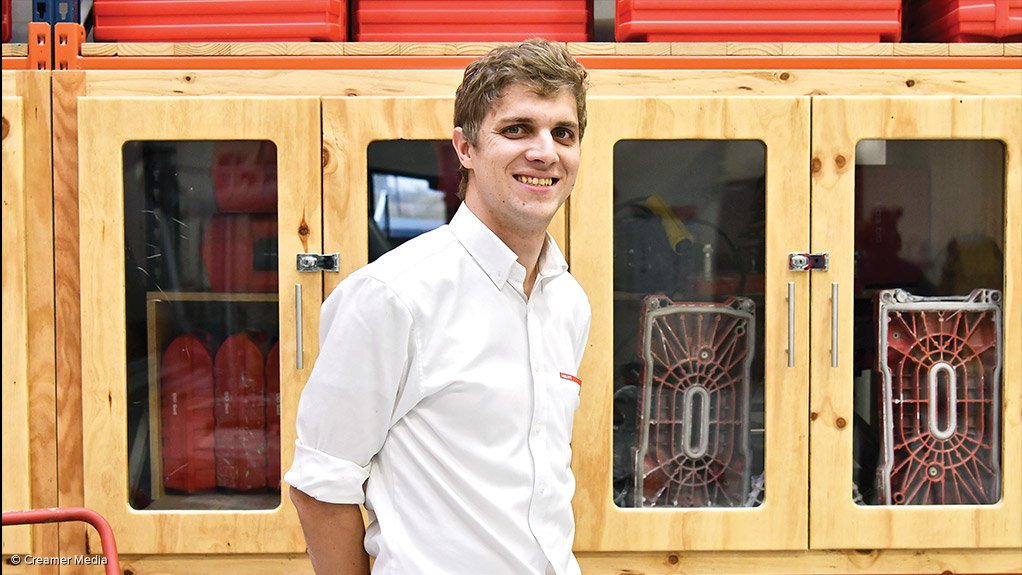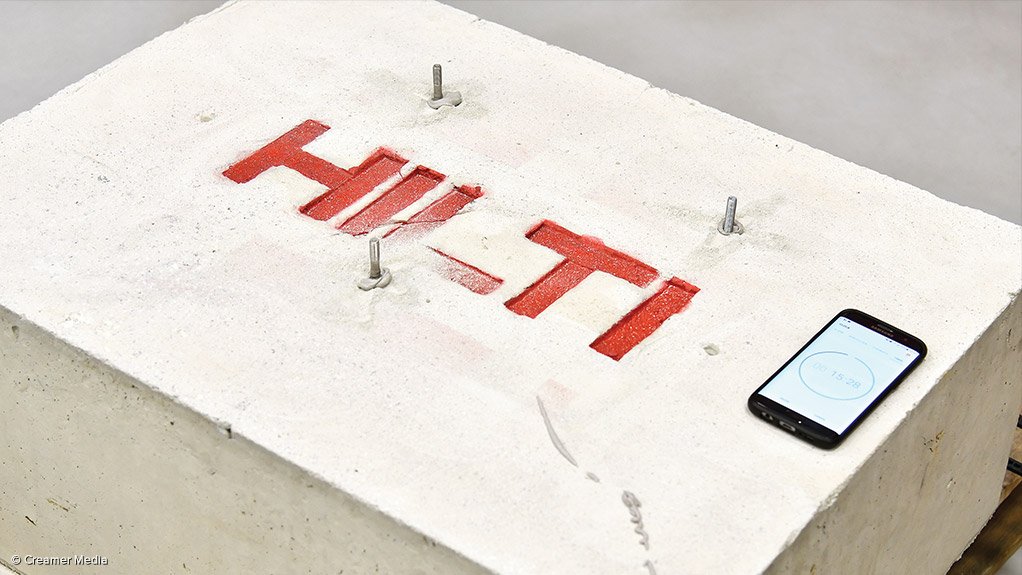Construction industry service and technology provider Hilti South Africa is offering two “innovative technologies” – the HIT-Z rod and advanced on-site testing – to ensure safety and reliability for chemical fasteners, Hilti South Africa engineering head Christiaan Davel tells Engineering News.
“These solutions form part of Hilti’s operating principle of taking conventional solutions in the construction industry, and developing technologies that can add value for the client – be it for the engineer or contractor – in the form of either cost and time savings, increased safety or increased loading.”
Davel indicates that these solutions were developed in response to specific client needs, with Hilti developing these to overcome challenges posed by chemical fasteners.
Both solutions were developed in Liechtenstein (Europe), where Hilti is headquartered. The HIT-Z rod was developed in 2014, and Hilti has been offering it to the South African market since 2015. Advanced on-site testing was developed and introduced to the South African market this year.
Chemical Fasteners
Davel explains that the working principle of a chemical fastener entails installing a steel stud or rod into a hole drilled into a base material, which is then bonded to the base material with a chemical mix. Base materials are typically concrete and masonry. Chemical fasteners are an alternative to mechanical fasteners, which work on the principle of a mechanical element expanding to secure into a base material.
Chemical fasteners gained popularity because of their higher load capacity, compared with mechanical fasteners, and a bond strength typically three to four times higher than that of the base material, making it ideal for high-loading applications. The higher bond strength enables fasteners to be fixed closer to the edge of base material, reducing space between the anchors and, subsequently, facilitating a reduction in the base plate’s size.
While the first modern chemical fasteners where patented in the 1960s, Davel indicates that they are “very sensitive to correct installation”. During installation, a lot of dust accumulates when drilling into the base material; therefore, the hole must be thoroughly cleaned during installation. If this is not done, the chemical bonds to the dust instead of the base material, greatly hindering the strength of the loading capacity, which could ultimately result in failure, he explains.
Davel notes that the necessary high-quality control to ensure proper cleaning is not implemented at all sites, which is often a factor when installing many fasteners, as it can be time-consuming and difficult to implement and supervise.
The HIT-Z rod enables clients to fully capitalise on the advantages of chemical fasteners while overcoming this challenge.
HIT-Z Solution
The HIT-Z’s spherical rod design differs from the conventional steel-threaded rod design. The shape, once tensioned, transfers the force of the applied torque to a horizontal force. Therefore, while a conventional rod depends on bonding to secure it, the HIT-Z rod is controlled instead by friction, thereby negating the need to clean the hole.
Davel enthuses that this creates peace of mind for clients, as they are assured of the required load performance.
Benefits of this solution include increased productivity, as cleaning time is negated. In terms of engineering benefits, this rod facilitates a reduced embedment depth, as it can achieve the same tensile capacity of a conventional rod with less depth. This equates to less chemical required for the hole, which, in turn, translates into cost savings, especially when many fasteners are installed. Moreover, this is ideal when drilling into a concrete reinforcement structure with dense reinforcement.
Davel notes that the HIT-Z is verified by the European Technical Approval Guidelines, which guarantee that it will perform as specified, supplementing Hilti’s in-house verification.
Market response to this solution has been “very good”, especially when clients understand the value proposition, he avers. In this regard, response from the steel and metal industry has been the most positive, followed by the building construction industry and the energy sector, adds Davel.
Hilti field engineer Ebert Mulder adds that this solution is being used at an almost-complete building project in Rivonia, Sandton, where the consulting engineers opted for it specifically for peace of mind and the benefits it offers. The fasteners are being used to support a composite deck.
On-Site Testing Solution
Hilti’s on-site testing is a paid-for service for engineers wanting to undertake nondestructive testing on site to verify or determine the loading capacity of a fastener.
Davel indicates that the company normally discourages on-site testing because conditions are not controlled, which can skew results, and its fasteners have third-party approval and are, therefore, reliable. However, he does note that on-site testing has value when the quality of the base material is not known.
Davel further cautions that on-site testing is prone to human error, which prompted Hilti to develop a device using an electric gauge to record consistent data to overcome this. The electric gauge is connected to a mobile phone through Bluetooth. Using the company’s application, this information is uploaded to a global server, after which it is analysed and returned to engineers in terms of design consistencies in accordance with global testing standards, which the engineers can then use to design solutions.
Davel notes an advantage of this solution is that it is creating a global database of base materials, which engineers will be able to tap into for conceptual designs.
“Hilti provides a variety of fastening solutions to cater for all customer needs supported by engineering design,” he concludes.
Edited by: Zandile Mavuso
Creamer Media Senior Deputy Editor: Features
EMAIL THIS ARTICLE SAVE THIS ARTICLE
ARTICLE ENQUIRY
To subscribe email subscriptions@creamermedia.co.za or click here
To advertise email advertising@creamermedia.co.za or click here















